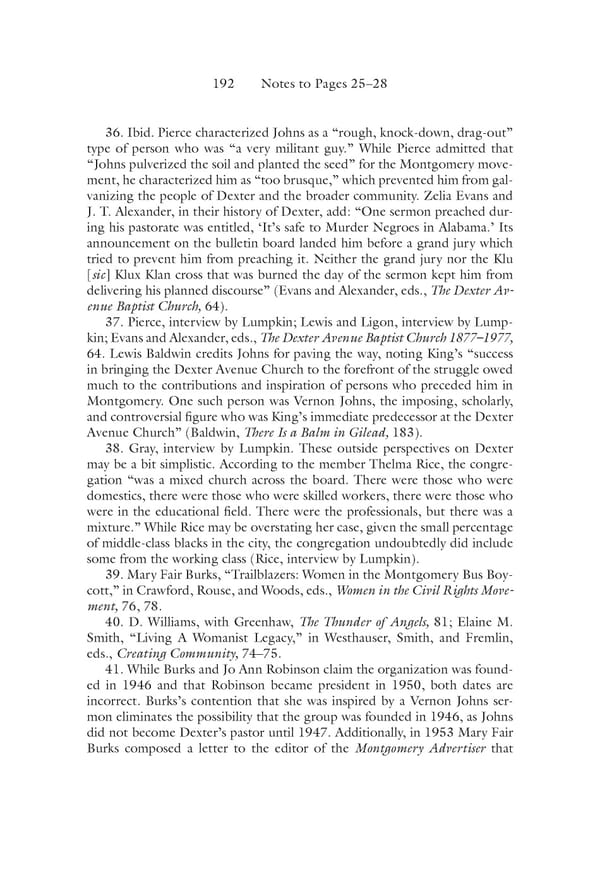192 Notes to Pages 25–28 36. Ibid. Pierce characterized Johns as a “rough, knock-down, drag-out” type of person who was “a very militant guy.” While Pierce admitted that “Johns pulverized the soil and planted the seed” for the Montgomery move- ment, he characterized him as “too brusque,” which prevented him from gal- vanizing the people of Dexter and the broader community. Zelia Evans and J. T. Alexander, in their history of Dexter, add: “One sermon preached dur- ing his pastorate was entitled, ‘It’s safe to Murder Negroes in Alabama.’ Its announcement on the bulletin board landed him before a grand jury which tried to prevent him from preaching it. Neither the grand jury nor the Klu [sic] Klux Klan cross that was burned the day of the sermon kept him from delivering his planned discourse” (Evans and Alexander, eds., The Dexter Av- enue Baptist Church, 64). 37. Pierce, interview by Lumpkin; Lewis and Ligon, interview by Lump- kin; Evans and Alexander, eds., The Dexter Avenue Baptist Church 1877–1977, 64. Lewis Baldwin credits Johns for paving the way, noting King’s “success in bringing the Dexter Avenue Church to the forefront of the struggle owed much to the contributions and inspiration of persons who preceded him in Montgomery. One such person was Vernon Johns, the imposing, scholarly, and controversial figure who was King’s immediate predecessor at the Dexter Avenue Church” (Baldwin, There Is a Balm in Gilead, 183). 38. Gray, interview by Lumpkin. These outside perspectives on Dexter may be a bit simplistic. According to the member Thelma Rice, the congre- gation “was a mixed church across the board. There were those who were domestics, there were those who were skilled workers, there were those who were in the educational field. There were the professionals, but there was a mixture.” While Rice may be overstating her case, given the small percentage of middle-class blacks in the city, the congregation undoubtedly did include some from the working class (Rice, interview by Lumpkin). 39. Mary Fair Burks, “Trailblazers: Women in the Montgomery Bus Boy- cott,” in Crawford, Rouse, and Woods, eds., Women in the Civil Rights Move- ment, 76, 78. 40. D. Williams, with Greenhaw, The Thunder of Angels, 81; Elaine M. Smith, “Living A Womanist Legacy,” in Westhauser, Smith, and Fremlin, eds., Creating Community, 74–75. 41. While Burks and Jo Ann Robinson claim the organization was found- ed in 1946 and that Robinson became president in 1950, both dates are incorrect. Burks’s contention that she was inspired by a Vernon Johns ser- mon eliminates the possibility that the group was founded in 1946, as Johns did not become Dexter’s pastor until 1947. Additionally, in 1953 Mary Fair Burks composed a letter to the editor of the Montgomery Advertiser that
 Becoming King: Martin Luther King Jr. Page 212 Page 214
Becoming King: Martin Luther King Jr. Page 212 Page 214